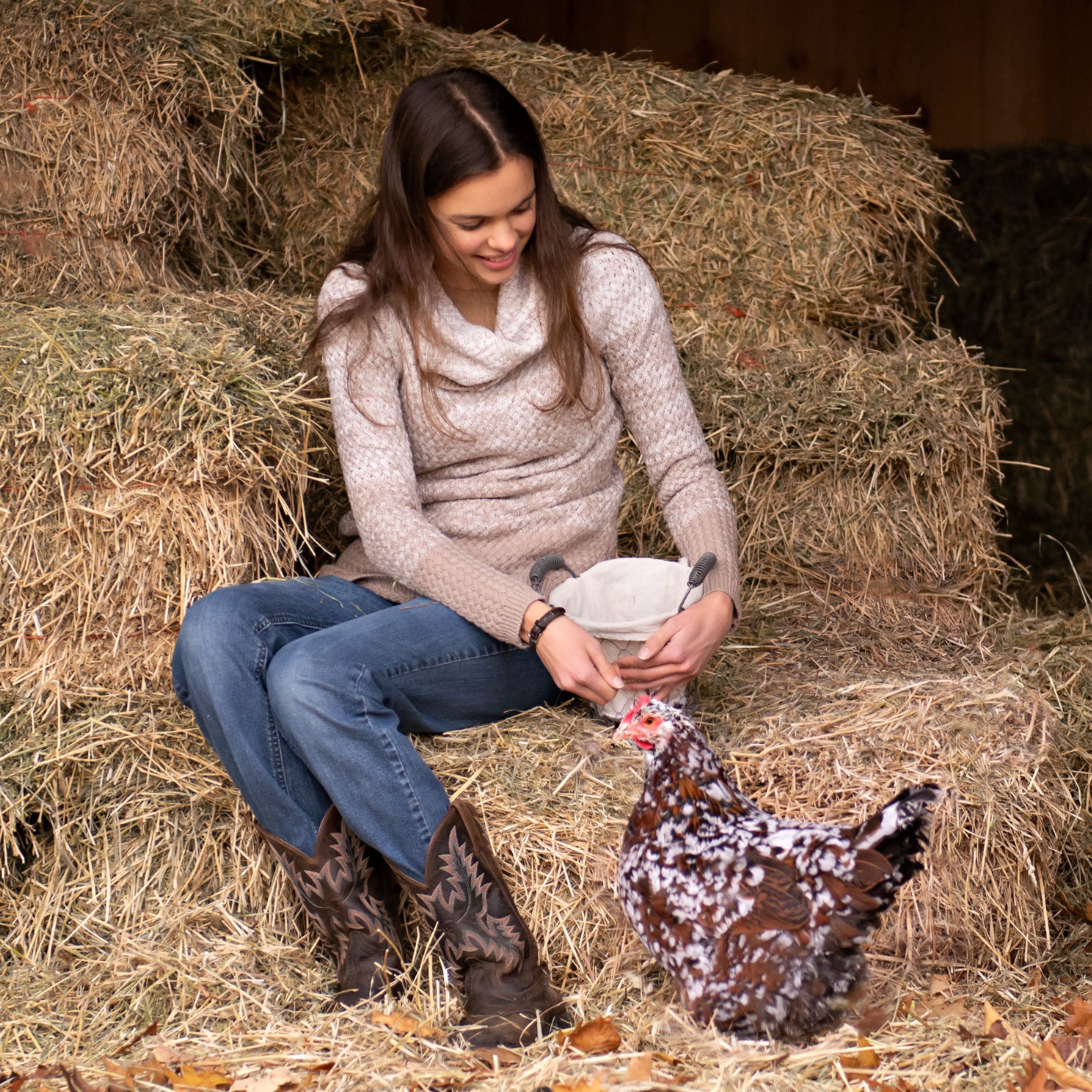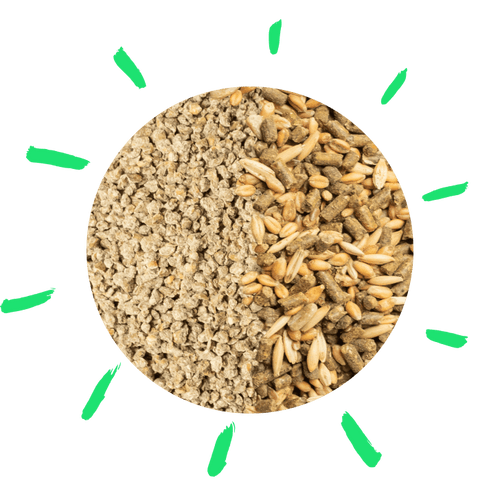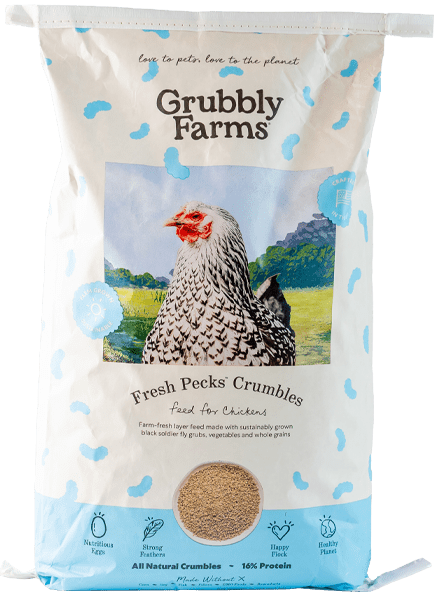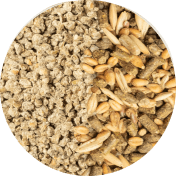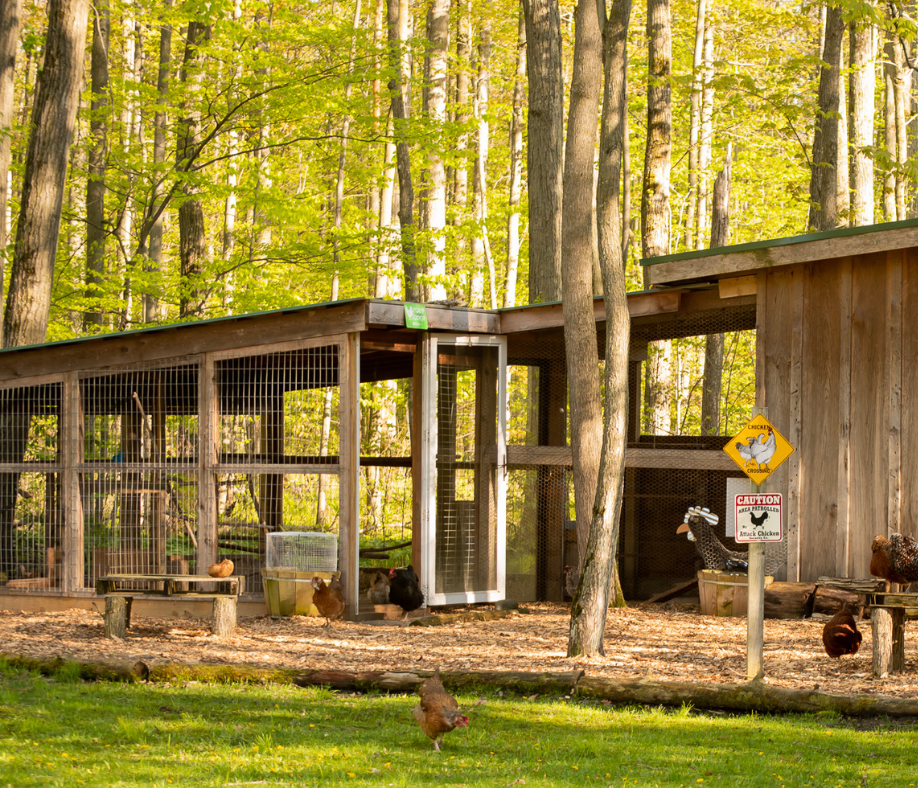Deciding what bedding to use in your chicken coop is important because coop bedding (or litter) plays a role in the daily care and overall health of your flock. Whether you are planning a chicken coop for your first flock or are considering switching to better bedding for your backyard flock, it’s a good idea to evaluate the pros and cons of each bedding type.
The bedding in the chicken coop functions to help manage droppings (chicken poop), keep the coop clean, and provides a soft and insulating flooring for your flock. So, understanding the different litter options will help you decide which litter is best for your coop.
The Pros & Cons of Chicken Coop Bedding Materials
The comfort and cleanliness of your chicken coop are key to the long-term health and success of your flock. This makes choosing the best bedding for your flock’s needs a decision that requires a bit of thought and planning. Here are some pros and cons of the most common litter materials along with how and why they work.
Wood Shavings

Wood shavings are popular and fairly common bedding to use in the chicken coop. They are usually economical to buy and can be sourced from local farm stores. Wood shavings are also absorbent and will help manage moisture from droppings. However, they will need daily to weekly maintenance to keep the wood shavings from becoming over-saturated or matted.
Maintaining Wood Shavings
To maintain wood shavings, you will need to stir and turn them on a regular basis to mix in the droppings. A long rake usually works well. If you use a droppings management system to remove the nightly droppings every day, then the wood shavings should only need to be stirred on a weekly basis.
Even with regular maintenance, wood shavings will still need to be completely replaced about every 3 to 4 months. Having to clean out the coop that frequently can be time-consuming and may build up expenses depending on how many bags of wood shavings you need to buy for each cleaning.
Each time you clean out the old, dirty wood shavings, you will want to replace them with a layer of fresh wood shavings that is about 5-6 inches thick. Wood shavings will compost and break down over time, which makes them a great litter to add to the compost pile when you clean out the coop!
Selecting the Best Wood Shavings for Your Coop
When choosing wood shavings, make sure you choose large flake shavings. Large flake shavings are less dusty and are less likely to be consumed accidentally by the chickens. Avoid using cedar shavings and opt for pine shavings or aspen shavings instead. It is also a good idea to use droppings boards or some other droppings management system for collecting nightly droppings to help extend the life of the wood shavings.
Wood shavings are a good chicken coop litter for beginner chicken keepers since they are easy to source locally and simple to maintain.
Pros
- Absorbent
- Fairly economical
- Easy daily or weekly maintenance
Cons
- Requires regular replacement
- Does not trap or retain heat well during cold temperatures
Straw

Straw is one of the most popular chicken coop bedding choices for northern chicken keepers. Straw is an excellent insulator, which makes it great to use during cold winter weather. Not only is it a good insulator, but it is also easy to maintain and chickens love sorting through straw!
Straw is often used as part of the deep litter method, which promotes the composting of droppings and prevents ammonia fumes from building up in the chicken coop during the winter. When the straw starts to compost, it can also generate heat which is helpful during the winter. Even if straw is not used as part of the deep litter method, its hollow shafts still help trap heat during cold weather.
While straw is not very absorbent, it can help manage moisture from droppings when the composting process is stimulated.
Your flock will sort through the straw flakes looking for leftover bits of grains, which provides a great boredom buster, but they will probably not be inclined to eat the long straw shafts unless they are very hungry!
Straw should not be used in warm regions where it may make the chicken coop too hot.
Maintaining Straw in Your Chicken Coop
Straw must be maintained on a daily to weekly basis to keep droppings from becoming matted or over-saturating the top layer of straw. Just like with wood shavings, regular turning must be done to mix the droppings in with the straw. The regular turning will also help aerate the litter and promote the composting process.
If you are using a droppings management system, like droppings boards, then the straw should only need to be stirred on a weekly basis.
Straw will need to be replaced about every 3 to 4 months since it will compost down and may become too saturated with droppings. This replacement cycle allows you to use straw as a winter and fall coop litter and then replace the straw with a different litter for the spring and summer.
Every time you replace the dirty straw, you will want to lay down a fresh layer of straw that is about 5 to 6 inches thick. Old, dirty straw can be added to the compost pile.
Selecting the Best Straw for Your Chicken Coop
Make sure you are buying good-quality straw bales and not hay. Straw has hollow shafts and is considered a livestock bedding. Hay is dried grasses and is considered animal feed, not bedding.
When you first introduce your flock to straw, you may be concerned about impacted crop. Consuming too much long, fibrous material (like bits of straw) can lead to impacted crop. To help avoid impacted crop, choose quality straw that is long-shafted and monitor your flock to make sure they are not interested in eating the straw.
Pros
- Composts well with droppings
- Can generate heat if using the deep litter method
- Helps trap heat during cold temperatures
- Easy daily or weekly maintenance
- Economical
- Can be used for the deep litter method
Cons
- Can cause impacted crop, not good to use during hot weather
- Organic straw and be difficult to source in some locations
- Chemically treated straw can be dangerous for chickens
- Can grow mold if not replaced often
Hemp

Hemp bedding continues to rise in popularity. This unique material offers a natural and eco-friendly alternative to straw for coops and nesting boxes. This material is made from the shafts of the cannabis plant and is a natural and highly beneficial byproduct of the growing hemp industry.
Hemp offers excellent absorbency while reducing odor (and the flies that odor attracts). In fact, most hemp litters have a higher absorbency rate than pine shavings and straw, boasting 400% absorbency compared to pine’s 250% and straw’s 125% absorbency.
It is also extremely soft compared to other forms of straw, and most hemp beddings are chemical-free. In addition to being cozy for your flock, hemp offers natural resistance against mites and other insects. Furthermore, many hemp beddings are less expensive than their pine and straw counterparts.
Finally, hemp is relatively dust-free–which is great for your chicken’s respiratory health.
Maintaining Your Hemp Bedding
When it comes to keeping your coop clean, hemp bedding offers longer-lasting odor and mess-control along with easy clean-up.
We recommend spot-cleaning your coop almost every day, removing any soiled hemp bedding in the process. However, you can turn and refresh your hemp bedding every other week or so.
Replace all of your hemp bedding and start anew every 3 to 4 months. Your soiled hemp litter can be composted! In fact, hemp offers a rapid compost rate compared to straw.
Pros:
- More cost-effective over time due to its long-lasting absorbency
- Eco-friendly
- Superior absorbency and odor control
- Soft texture
- Natural pest control
- Easy clean-up
- Less prone to growing mold compared to straw
Cons:
- May not be available at every feed or big box store
Sand

Sand is another chicken coop litter option most people consider. Sand has a fairly good absorbency factor and is a well-draining litter. One reason why many chicken keepers choose to use sand is that it can be more economical than wood shavings or straw in the long run. As long as the sand is well maintained, it will not have to be replaced as often as wood shavings or straw.
Initially buying sand for the chicken coop may seem expensive, but you don’t have to buy sand as often as you would wood shavings or straw, which may end up saving you money and time.
Sand does work as a good temperature stabilizer within the coop. During cold temperatures, the sand can help the chicken coop remain at a stable, warmer temperature. This is especially true if the daytime is warmer, allowing the coop to warm up and trap heat inside. Sand can also help keep the coop cool during hot weather. As long as the internal temperature of the coop remains fairly cool, the sand will help insulate against the hotter environmental temperatures outside.
Sand is a good litter to use in temperate climates and can be an economical litter choice. However, it does need to be cleaned on a daily basis.
Maintain Sand for Your Coop Litter
If maintained properly, you may only need to replace the sand in the chicken coop every 1 to 3 years. You should also make sure the sand is at least 4 to 5 inches thick to maximize absorbency and drainage.
Even though sand is good at absorbing and draining moisture, it will not compost the droppings, allowing them to build up if they are not removed. A daily cleaning routine will need to be maintained to remove droppings from the sand.
The downside to sand comes from regular maintenance. For wood shavings and straw, you just need to stir in the droppings on a regular basis. Sand on the other hand, you will need to clean out the droppings on a daily basis to prevent them from building up.
Nightly droppings management systems can be used to minimize how many droppings end up in the sand at night. A kitty litter scoop can be used to sift any daytime droppings from the sand on a daily basis.
Sand = Dust
Sand also has a tendency to become dusty. Due to its extended use in the coop, it has more time to gather and trap dust that is naturally created by chickens (chicken dust). Also, if you use a dusty chicken feed, the sand will become dust-laden and may be hard to clean without creating a dust cloud. Minimize the amount of dust that sand traps by feeding your flock a low-dust feed and regularly vacuuming off windows and other surfaces that collect dust in the chicken coop.
Selecting Sand for Your Coop Litter
When buying sand, make sure you are getting coarse construction-grade sand, not play sand. Play sand has usually been treated with chemicals that can be harmful for your flock. Construction-grade sand is coarser and will be better at draining and absorbing moisture. The coarser texture also prevents the chickens from accidentally consuming too many fine sand particles which can lead to crop problems.
Pros
- Decent absorbency and good drainage
- Fairly economical since it doesn’t need regular replacement
- Provides a natural source of grit
- A good temperature stabilizer
Cons
- Needs to be cleaned daily
- Does not compost
- Can become dusty due to dusty feed and extended use
Natural Bedding

Natural bedding options can be an economical litter choice for your chicken coop. Natural litters include using dried leaves or dried pine needles as a coop litter.
The most important factor to remember when using natural litter options is that the leaves or pine needles MUST be completely dry. Natural litters that are still damp when put in the coop will start to mold and become dangerous for your flock to be around.
Natural litter will help compost the droppings in the chicken coop. You must start with a layer that is about 5 to 6 inches thick and you should turn or stir the litter on a daily or weekly basis to ensure the droppings don’t become matted. Stirring also encourages the composting process. Using a nightly droppings management system, like droppings boards, can help extend the life of the natural litter.
Natural litter options can be an economical choice if you have access to a free source and you take the precautions of ensuring the litter is completely dry before using it in the chicken coop.
Maintaining Natural Litter in Your Coop
Natural litter will also need to be replaced on a more regular basis than wood shavings or straw. Since they break down so quickly, natural litter should be replaced as frequently as needed or at least every 2 to 3 months. However, they can still be an economical litter option if you have access to a free or cheap source of dried leaves or pine needles.
Selecting the Best Natural Litter for Your Coop
When using dried leaves or pine needles as a natural litter, make sure you are gathering the litter from a safe source. Avoid sources that may contain traces of chemicals or pesticides, which are harmful to your flock. Also, when gathering dried leaves, try to avoid using oak leaves which are higher in harmful tannins than leaves from other trees.
Pros
- Helps compost the dropping
- Economical
- Can be used in conjugation with the deep litter method
- Will generate some heat when composting
Cons
- Must be completely dry
- Prone to molding and moisture buildup
- Not very absorbent
- Requires daily maintenance to prevent droppings buildup
- Not good insulators or temperature stabilizers
Shredded Paper

While shredded paper can be used as a chicken coop litter, it is not a highly recommended litter for long time use in the coop. The one reason why shredded paper is used as a coop litter is that it can be economical if you have access to a free or cheap source.
However, it does come with many concerns for the health of your flock and is usually a high-maintenance litter. Shredded paper is very absorbent, which is a good quality in chicken coop litter. However, it is so absorbent that it can quickly become soggy and won’t dry out properly. Wet litter encourages the buildup of ammonia fumes, can mold, and will create manure mats in the chicken coop.
Maintaining Your Shredded Paper Litter
Due to its highly absorbent nature, shredded paper must be replaced every month or as frequently as every week if it becomes too soggy.
Just like with wood shavings and straw, shredded paper must be stirred or turned every day to mix in the droppings. Since shredded paper takes a long time to compost, it does not do a very good job of managing the droppings even when you do stir the shredded paper on a daily basis. Using a nightly droppings management system is extremely helpful when using shredded paper to minimize how many droppings accumulate in the litter.
It's important that you have a thick layer of shredded paper, at least 6 inches thick, to provide amply bedding for the chickens. Shredded paper can mat down very quickly, so you may need to keep more on a daily basis if it is not quite ready for a complete change ou
Selecting the Best Paper for Your Coop Litter
When using shredded paper, avoid using highly inked shredded paper. The ink will make the paper less absorbent and can become slippery when wet.
Shredded paper is also dangerous if chickens accidentally consume the litter, especially shredded paper that is highly inked. Accidental litter consumption can happen if litter gets ditched into the feeder, flung into the water source, or sticks to any treats or snacks you feed the flock.
In the end, shredded paper is probably not the best litter choice for the chicken coop. If anything, use shredded paper as an emergency litter if you can’t get your hands on some other type of litter right away during a coop cleaning.
Pros:
- May be economic
Cons
- Extremely absorbent to the point of becoming soggy quickly
- Highly inked paper will be slippery for chickens to walk on
- Potentially hazardous if consumed
- Does not compost easily
Choosing the Right Litter for Your Coop
A good litter in the chicken coop will absorb moisture from the droppings and either make the droppings easier to clean up or compost the droppings right in the coop. Choosing the best litter for your chicken coop will depend on your budget, how much time you have to maintain the litter, sources of litter in your area, and your region’s weather patterns.
Northern chicken keepers who experience cold weather year-round may choose straw as a good coop litter. In temperate or hot regions, wood shavings or sand make a better option. Natural litter can be a good option if you have access to large quantities of a dry natural litter source.
In the end, you want the litter in the chicken coop to provide a cushy surface for your flock to walk on and to be functional in managing droppings. A good litter along with proper litter maintenance will help the coop stay fresh and smell good leading to a happy, healthy flock!
If you’re enjoying reading about chicken coop maintenance, you will love these 7 coops you’ll want to live in!

